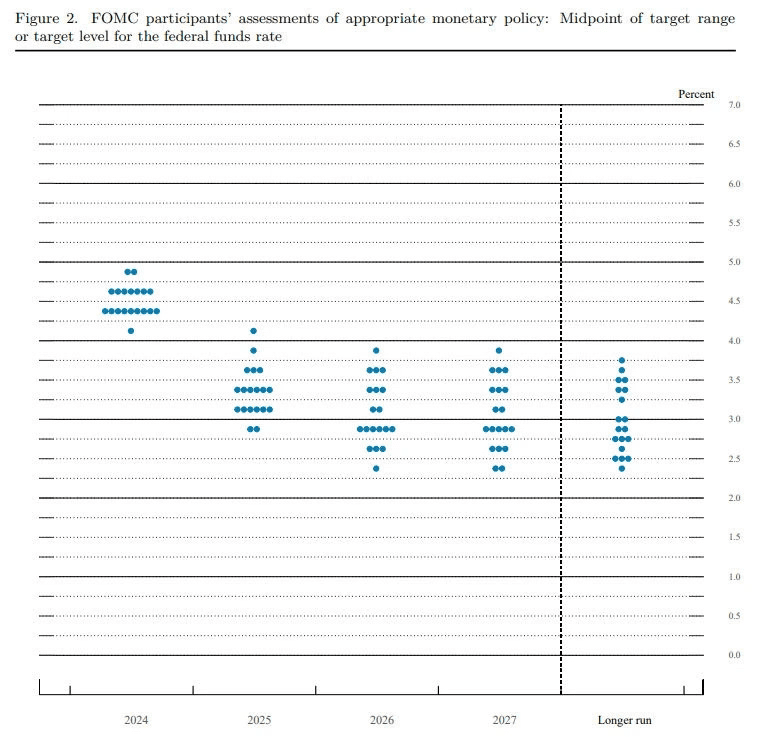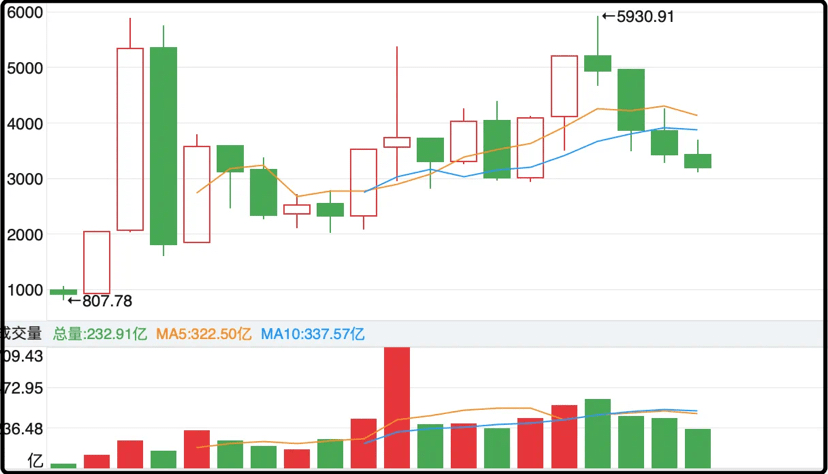As you can see, the Fed ultimately chose to cut interest rates by 50 basis points.
The Federal Reserve then released the latest interest rate dot chart, as follows:

Let me give a brief update for new readers. The vertical axis of this graph is the interest rate, with the numbers on the far right, and the horizontal axis is time, in years.
Every year, there are 19 points, which represent the votes of 19 members of the Federal Reserve, including the members of the Federal Reserve Board and the presidents of the Federal Reserve Banks. The votes are secret, and you can see that in 2024, one person voted for the lowest 4-4.25%, but the public does not know who voted for this.
The dot plot is updated four times a year, once in March, June, September and December. According to this dot plot, it can be seen that the average expected interest rate at the end of 2024 is 4.4%, 3.4% at the end of 2025, and 2.9% at the end of 2026. The longer-term interest rate is also around 3%.
But please note that this only represents the current expectations. With the update of economic data every month, the attitudes of the committee members will change quickly. In fact, it is very different from the one in June. They mainly look at two data, inflation rate and employment. They want to prevent inflation from getting out of control and unemployment from rising. Then they swing back and forth to find a balance.
I think this decision-making system is very mature, open and transparent, and maintains communication with the market. Collective and flexible decision-making avoids the paranoia of a few people in power. For example, we foreign investors can also understand their current and future policy expectations. In contrast, our own central bank in China usually only uses general adjectives such as prudent, cautious, and positive, and then lets the market figure out the rest. As for who makes the decision, when the decision is made, and what the decision is based on, the official rarely tells the public, and everyone is just guessing.
Tomorrow is the 20th of every month and the LPR will be updated again. Everyone is worried and wondering whether it is time to cut interest rates. However, it is all guesswork and no one knows whether there will be a cut in the end.
Back to the Fed, there are two more interest rate meetings this year, and the market generally expects both to be cut. The current expectation is a 0.25% cut each time, plus this 0.5%, for a cumulative 1% cut in 2024. This speed and magnitude are quite fierce. It took three years to come, but now that the turning point has been reached, it is a drastic measure.
Although monetary easing is very resolute, the market's expectations for US stocks in the coming year are not very optimistic. Many people are ready to cash in on the good news, but after all, the stock market has indeed risen a lot in the past two years.
As for the RMB exchange rate, it rebounded to around 7.06 today, but I don't think there is a driving force for continued appreciation. It's a simple math problem. Even if they drop to 4.4% by the end of the year and 3.4% by the end of next year, it's still high interest rate relative to the RMB. Our domestic interest rate will be 2% in the future, and the market will soon realize this. In addition, the economy is weak now, and if the RMB appreciates, it will increase the difficulty of exports.
Anyway, the comments last night about the tens of trillions of offshore funds flowing back to A-shares were a joke. It won't have such an effect. But it's true that the village will distribute gold bars next week. Look at my serious face.
……
Today, A-shares fell first and then rose, finally ushering in the long-awaited Zhongyang, the market volume exceeded 600 billion, the median +2.19%, it feels like I haven't had such a good meal for a long time. It's hard to say that it has nothing to do with the Fed's interest rate cut last night, but now I'm afraid that the LPR announced tomorrow will fail to cut interest rates again, and then I will be beaten up.
I have been thinking that A-shares will have a purely technical oversold rebound, at least at the level of 4%-8% of the entire market, but it just won't come. My biggest feeling in the past two years is that the experience system has been gradually invalidated, such as the long-term trend line that has continued for 30 years has been broken, and various extreme cycles have been broken.
Last year I said that the CSI 300 had never had three consecutive negative annual lines in history. This year I said that the CSI 300 had never had four consecutive negative annual lines in history. Now I am beginning to doubt whether there will be five consecutive negative annual lines next year.

This is a bit like building a river embankment, saying it can prevent a flood that occurs once every 50 years, but it does not necessarily mean that nothing will happen in 50 years. Maybe a flood that occurs once every 100 years will come in the next year. We are now experiencing the turning point of the 40-year cycle. Many previous historical experiences are not only useless, but may become negative assets when you make judgments.
Today, the A-share sectors that led the gains are all consumption-related, such as liquor, food, beverages, and home appliances. There are two possible logical reasons. One is that some foreign capital did choose to return to the Chinese market after the Federal Reserve cut interest rates. The other is that the market expects that future mortgage interest rate cuts will boost domestic consumption. Don't jump to conclusions. Who knows if the market will fall again in the next few days?
……
1. Musk said his brain-computer product can help blind people restore their vision, and even let people born blind see the world for the first time. Neuralink recently received breakthrough medical device certification from the U.S. Food and Drug Administration (FDA) for its "Blindsight" project, which means that both research and development and market approval will be accelerated.
I think the most disgusting thing about this product is that it requires a hole in your skull and then implants the chip, so it is unlikely to be widely used by civilians. No one wants to have a hole in their head.
If technology that can receive brain waves through the scalp can be developed in the future, that will be the beginning of true large-scale commercial use. At present, this news is only for hype and has little actual value.
2. The explosion of electronic products planned by Israel has made many countries in the Middle East feel insecure, so they have turned to China to purchase large quantities of finished equipment. Some companies that make pagers and walkie-talkies have hit their daily limit today, but the market demand in this area is not large and will cool down in a few days.
3. Shipbuilding and heavy industry resumed trading. I analyzed last night that the merger plan was not good for heavy industry, so the ship opened high and closed low, and the heavy industry opened low and closed low, both of which were negative lines. The ship started better and still rose. The merger of central enterprises can be speculated in a bull market, but it is pure waste in a bear market.
4. A 44-year-old man in Shenzhen stabbed a 10-year-old Japanese elementary school student to death near a school in front of the child's mother. This incident has fermented in the Japanese media and the Japanese community, and has attracted great attention from Japanese personnel in China. I am really sorry that there are such rubbish among the Chinese. I am ashamed and embarrassed.




